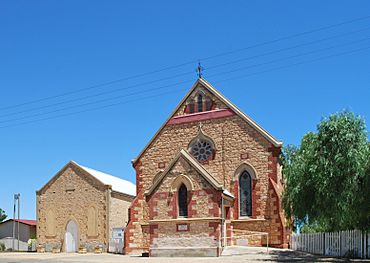Port Wakefield, South Australia facts for kids
Quick facts for kids Port WakefieldSouth Australia |
|||||||||||||||
|---|---|---|---|---|---|---|---|---|---|---|---|---|---|---|---|

The Uniting Church at Port Wakefield
|
|||||||||||||||
| Postcode(s) | 5550 | ||||||||||||||
| Time zone | ACST (UTC+9:30) | ||||||||||||||
| • Summer (DST) | ACST (UTC+10:30) | ||||||||||||||
| Location | 99 km (62 mi) North West of Adelaide city centre via |
||||||||||||||
| LGA(s) | Wakefield Regional Council | ||||||||||||||
| State electorate(s) | Narungga | ||||||||||||||
| Federal Division(s) | Grey | ||||||||||||||
|
|||||||||||||||
| Footnotes | Adjoining localities | ||||||||||||||
Port Wakefield is a town in South Australia. It sits at the mouth of the Wakefield River, at the top of the Gulf St Vincent. This town was the first government-planned town built north of Adelaide, the state capital. Port Wakefield is about 99 kilometers (61 miles) from the Adelaide city centre. It is located on the main A1 National Highway.
Port Wakefield is an important stop for travelers. People going to the Yorke Peninsula, Port Augusta, the Flinders Ranges, Eyre Peninsula, or even the Nullarbor Plain often pass through here. Because of its key location, Port Wakefield has many roadhouses and trucking stops.
Just north of the town, there is a big intersection. Here, traffic heading to the Yorke Peninsula turns west onto the Copper Coast Highway. This intersection is known for traffic jams and sometimes accidents, especially during holidays.
Contents
History of Port Wakefield
- Further information: Port Wakefield railway line
The town was first called Port Henry by William Hill. Its name changed to Port Wakefield around 1849. It was named after the Wakefield River.
In 1848, a company called the Patent Copper Company decided to build a smelter in Burra. To save money on moving copper, they surveyed a path to a port. This port was at the mouth of the Wakefield River. The company got special permission to control this port. The path became known as the Great Western Road. Workers built a wharf along the river. Cargo was moved between the wharf and ships using smaller boats called lighters.
When a railway opened from Adelaide to Gawler in 1857, the copper company stopped using Port Wakefield. Only farm products continued to come through the port. In the mid-1860s, mixed farming started along the river. This meant better transport was needed to the port.
Early Railways
William Hanson, who managed railways, chose a path for a horse-drawn tramway. It ended at a place called Hoyles Plains, which later became Hoyleton. This tramway was about 46 kilometers (28 miles) long. It was the first railway in South Australia built with a track width of 1067mm. The government decided a private company should run the line. Paul Badcock won the bid and opened the line in January 1870. Horses worked in three shifts along the route.
This railway had its own port, so it did not need to connect with other wider railways. This avoided problems with different track sizes. The government took over the line at the end of 1870.
In March 1876, the line was extended from Hoyleton to Blyth. Steam locomotives were brought in. By August 1876, steam engines were used for the whole line. The line was also extended from Port Wakefield to Kadina in October 1878. It reached Wallaroo and Moonta by 1891. This became known as the Balaklava-Moonta railway line.
In 1927, these railways were changed to a wider track size of 1600mm. However, this railway line eventually became old and was no longer needed. The tracks were removed by the late 1980s.
Community and Events
A Methodist chapel was built in 1868. A local stonemason and carpenter built it. Today, it is still used as a Uniting Church.
The 1955 Australian Grand Prix was held at the Port Wakefield Circuit. This race track was east of the town. It opened in 1953 because public road racing was not allowed. The circuit closed in 1961. Some of its equipment was moved to the longer Mallala Race Circuit.
Highway Upgrades
Before the 2018 state election, the Liberal Party suggested building an overpass. This would help reduce traffic problems at the intersection of the Augusta Highway and Copper Coast Highway. The party won the election. They then planned to completely separate the intersection levels. They also planned to add another lane to the highway through Port Wakefield.
In March 2020, a special team of construction companies was chosen for the project. This team is called the "Port Wakefield to Port Augusta Alliance." They are responsible for making the Port Wakefield Road wider through Port Wakefield. They will also build the new intersection with the Copper Coast Highway. This same team is also working on widening the Joy Baluch AM Bridge in Port Augusta. Both projects are expected to be finished in 2022.
Media and News
In 1876, a newspaper called the Port Wakefield Times was printed in the town. It was published for only a short time. Later, another newspaper called the Wakefield Sun was published from 1910 to 1912. The Port Wakefield Monitor was also published locally from 1915 to 1941.


